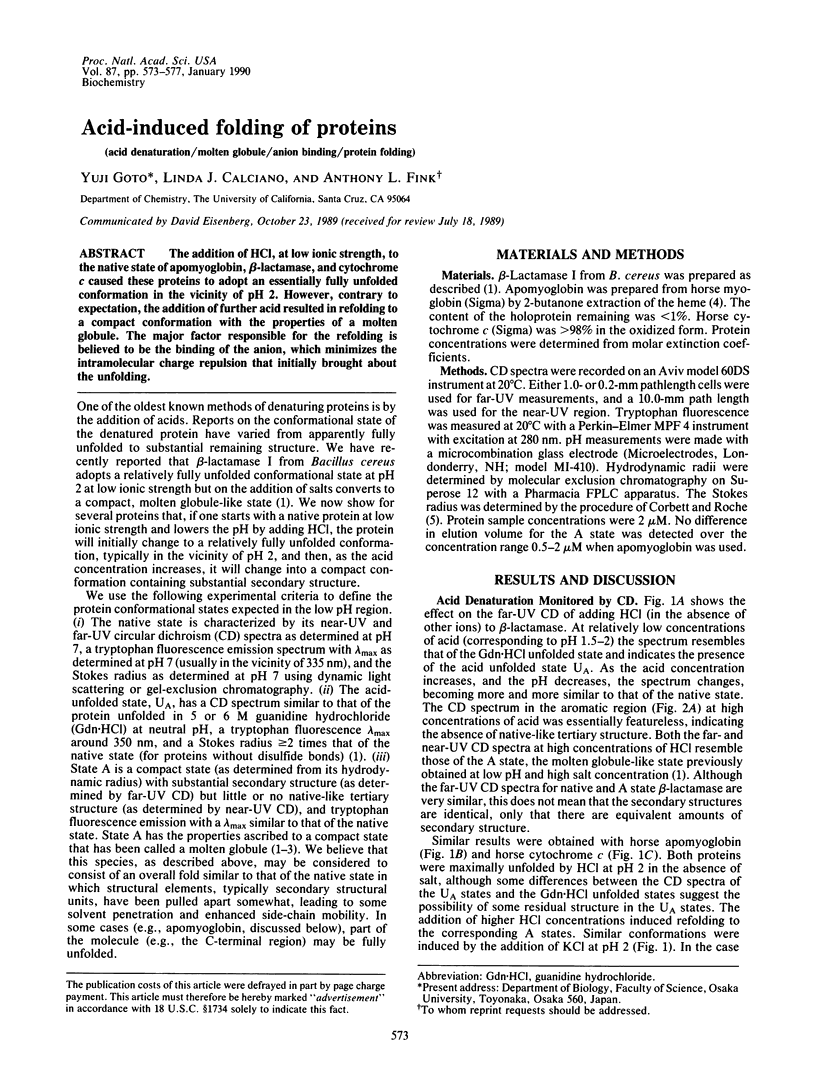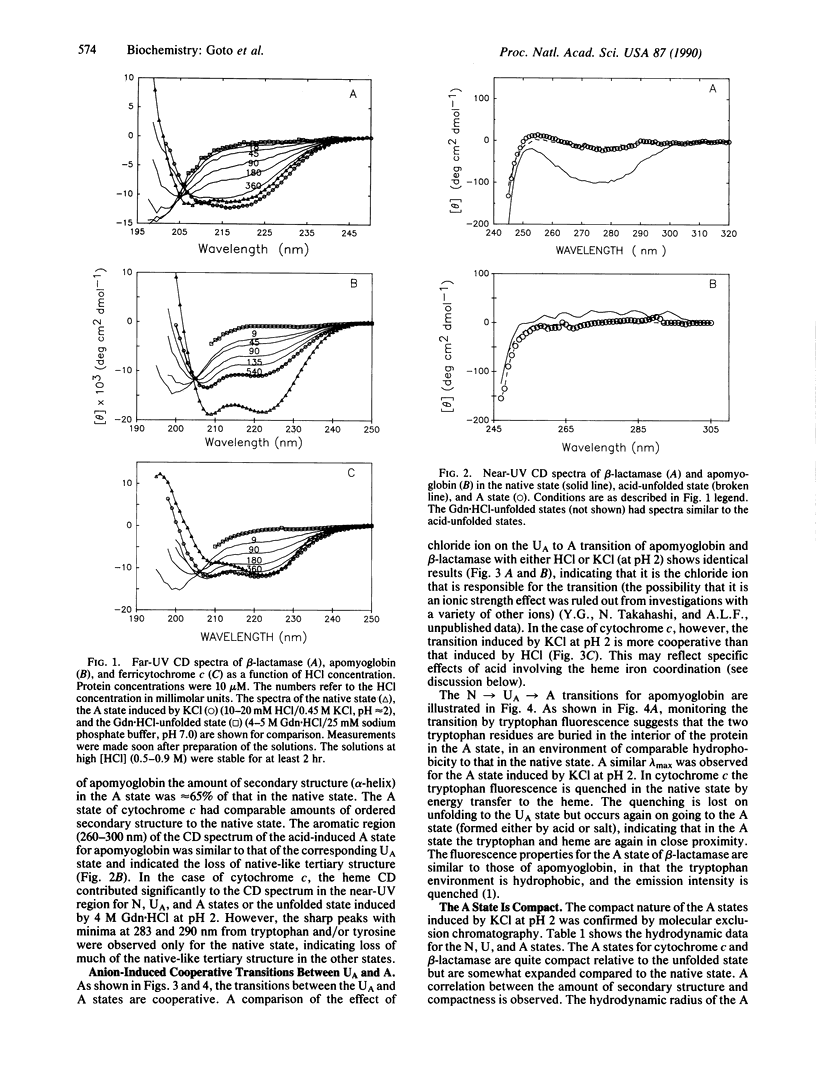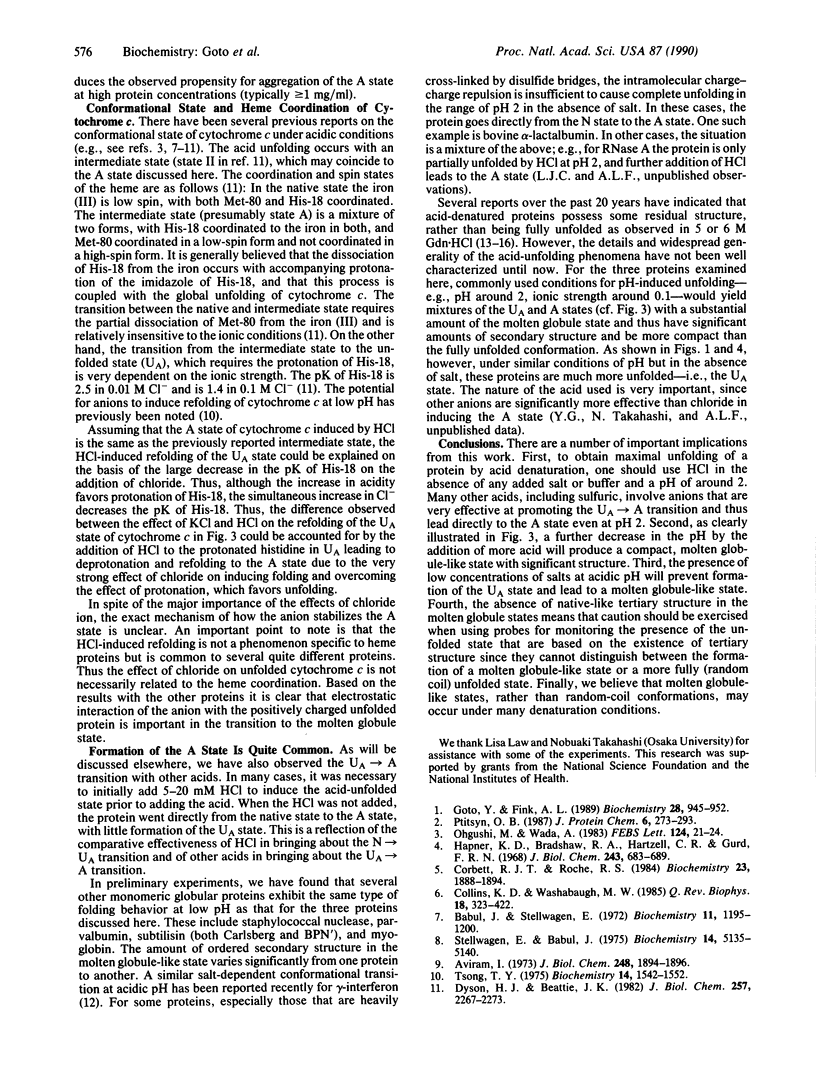Abstract
The addition of HCl, at low ionic strength, to the native state of apomyoglobin, beta-lactamase, and cytochrome c caused these proteins to adopt an essentially fully unfolded conformation in the vicinity of pH 2. However, contrary to expectation, the addition of further acid resulted in refolding to a compact conformation with the properties of a molten globule. The major factor responsible for the refolding is believed to be the binding of the anion, which minimizes the intramolecular charge repulsion that initially brought about the unfolding.
Full text
PDF




Selected References
These references are in PubMed. This may not be the complete list of references from this article.
- Arakawa T., Hsu Y. R., Yphantis D. A. Acid unfolding and self-association of recombinant Escherichia coli derived human interferon gamma. Biochemistry. 1987 Aug 25;26(17):5428–5432. doi: 10.1021/bi00391a032. [DOI] [PubMed] [Google Scholar]
- Aune K. C., Salahuddin A., Zarlengo M. H., Tanford C. Evidence for residual structure in acid- and heat-denatured proteins. J Biol Chem. 1967 Oct 10;242(19):4486–4489. [PubMed] [Google Scholar]
- Aviram I. The interaction of chaotropic anions with acid ferricytochrome c. J Biol Chem. 1973 Mar 25;248(6):1894–1896. [PubMed] [Google Scholar]
- Babul J., Stellwagen E. Participation of the protein ligands in the folding of cytochrome c. Biochemistry. 1972 Mar 28;11(7):1195–1200. doi: 10.1021/bi00757a013. [DOI] [PubMed] [Google Scholar]
- Collins K. D., Washabaugh M. W. The Hofmeister effect and the behaviour of water at interfaces. Q Rev Biophys. 1985 Nov;18(4):323–422. doi: 10.1017/s0033583500005369. [DOI] [PubMed] [Google Scholar]
- Corbett R. J., Roche R. S. Use of high-speed size-exclusion chromatography for the study of protein folding and stability. Biochemistry. 1984 Apr 10;23(8):1888–1894. doi: 10.1021/bi00303a047. [DOI] [PubMed] [Google Scholar]
- Dyson H. J., Beattie J. K. Spin state and unfolding equilibria of ferricytochrome c in acidic solutions. J Biol Chem. 1982 Mar 10;257(5):2267–2273. [PubMed] [Google Scholar]
- Goto Y., Fink A. L. Conformational states of beta-lactamase: molten-globule states at acidic and alkaline pH with high salt. Biochemistry. 1989 Feb 7;28(3):945–952. doi: 10.1021/bi00429a004. [DOI] [PubMed] [Google Scholar]
- Hapner K. D., Bradshaw R. A., Hartzell C. R., Gurd F. R. Comparison of myoglobins from harbor seal, porpoise, and sperm whale. I. Preparation and characterization. J Biol Chem. 1968 Feb 25;243(4):683–689. [PubMed] [Google Scholar]
- Ohgushi M., Wada A. 'Molten-globule state': a compact form of globular proteins with mobile side-chains. FEBS Lett. 1983 Nov 28;164(1):21–24. doi: 10.1016/0014-5793(83)80010-6. [DOI] [PubMed] [Google Scholar]
- Stellwagen E., Babul J. Stabilization of the globular structure of ferricytochrome c by chloride in acidic solvents. Biochemistry. 1975 Nov 18;14(23):5135–5140. doi: 10.1021/bi00694a018. [DOI] [PubMed] [Google Scholar]
- Tanford C. Protein denaturation. Adv Protein Chem. 1968;23:121–282. doi: 10.1016/s0065-3233(08)60401-5. [DOI] [PubMed] [Google Scholar]
- Tsong T. Y. An acid induced conformational transition of denatured cytochrome c in urea and guanidine hydrochloride solutions. Biochemistry. 1975 Apr 8;14(7):1542–1547. doi: 10.1021/bi00678a031. [DOI] [PubMed] [Google Scholar]
- Wong K. P., Hamlin L. M. Acid denaturation of bovine carbonic anhydrase B. Biochemistry. 1974 Jun 18;13(13):2678–2683. doi: 10.1021/bi00710a003. [DOI] [PubMed] [Google Scholar]


